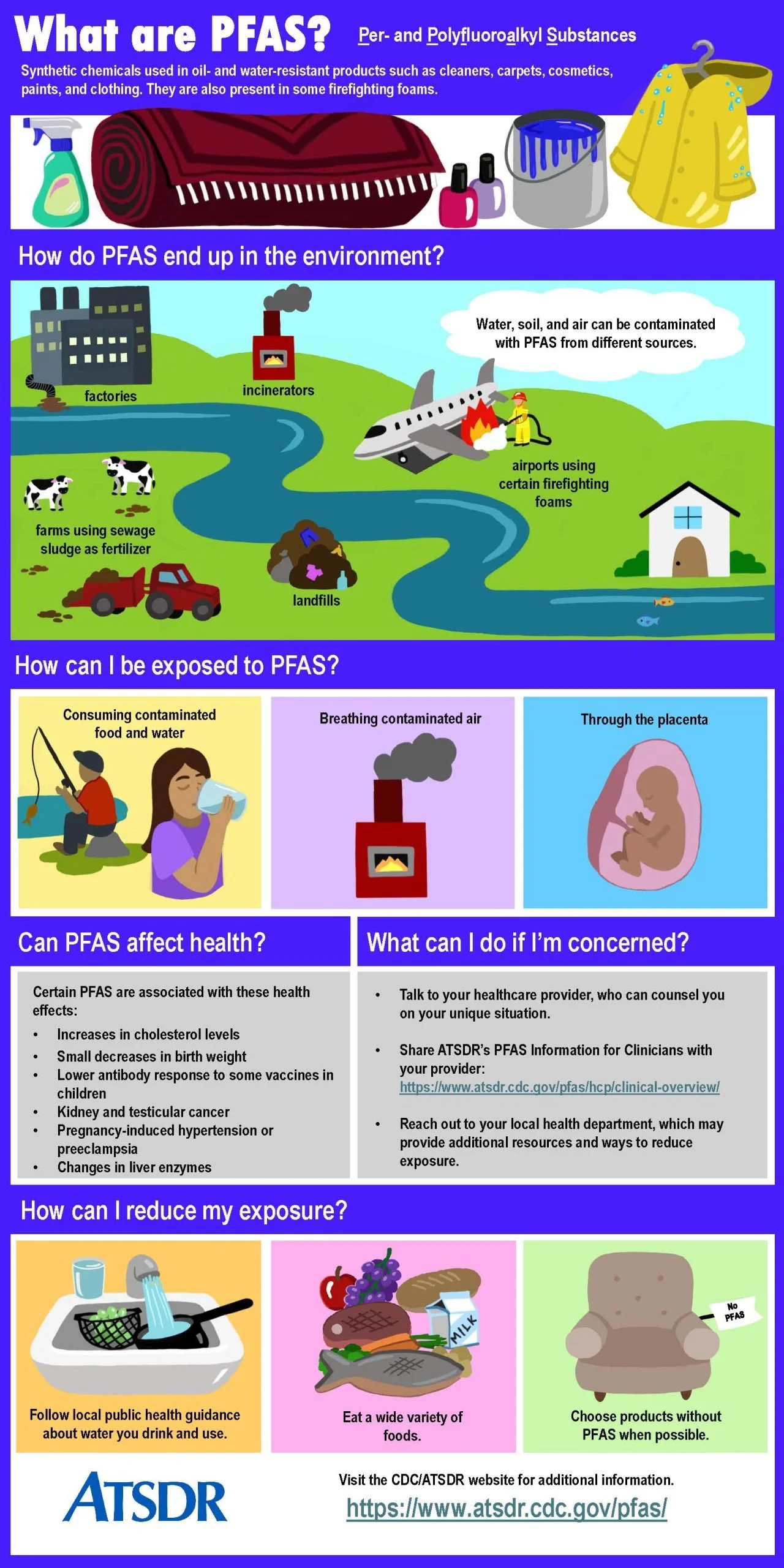
What are PFAS?
What are PFAS and why should I be concerned?
PFAS are a large class of over 15,000 chemicals used in hundreds of everyday products and industrial applications. (1) They make things non-stick, waterproof, grease-resistant, and stain-resistant.
These chemicals didn’t even exist before the 1940s, when a DuPont chemist created the first PFAS. Today, over 98% of people in the U.S. have PFAS in their blood. (2) PFAS have also been found in wildlife, soil, and water around the world. (3)
The PFAS that have been studied are toxic at extremely low levels. They’ve been linked to:
Several types of cancer
Reproductive and developmental problems
Weakened immune systems
PFAS are often called “forever chemicals” because they don’t break down, not for hundreds or even thousands of years. They also build up in our bodies over time. As long as PFAS keep being made and used, their levels will rise in people and the environment, increasing the risk of serious illness. (4)
That’s why local action matters. By reducing exposure and demanding safer alternatives, you can play a powerful role in protecting your community.
Can PFAS cause health problems?
YES. Exposure to PFAS has been linked to a wide range of serious health effects. Pregnant individuals, babies, and children are especially at risk because their developing bodies are more sensitive to toxic chemicals. Even very low levels in the body may increase the risk of (5):
Testicular, kidney, liver, breast, and pancreatic cancer
Immune system suppression, including reduced response to vaccines
Low birth weight and congenital disabilities
Endocrine disruption, which can affect hormones and development
Increased cholesterol and related cardiovascular risks
Weight gain and metabolic changes
Ulcerative colitis
High blood pressure, including preeclampsia during pregnancy
PFAS contamination doesn’t affect everyone equally.
Communities living near industrial sites, airports, or military bases, which can often be communities of color or low-income people, are more likely to be exposed to high levels of PFAS. (6) The Agency for Toxic Substances and Disease Registry (ATSDR) notes that the risk of health effects depends not only on exposure but also on a person’s other health conditions, and access to resources like safe water and medical care. (7)
Numerous studies have shown there are increased risks to PFAS exposure and health effects from (8):
Living near contaminated water supplies, farms, or incineration sites
Working in jobs with increased exposure, including firefighting, agriculture, or chemical manufacturing
Fishing for subsistence, hunting, or consuming food grown in contaminated areas
Belonging to Indigenous communities with strong ties to affected lands and water
Having limited English proficiency can limit access to information
Lacking access to health care, safe drinking water, or effective filtration
How am I exposed to PFAS?
People are exposed to PFAS by drinking contaminated water, eating contaminated food, and using products that contain PFAS.
-
PFAS in consumer products get into household air and dust. We breathe in PFAS and can also absorb PFAS that is in contact with our skin. PFAS are in (9):
Children’s products, including car seats, strollers, mattresses, and most things labeled waterproof or stain-proof
Carpets and rugs
Clothing and shoes, including everyday apparel and waterproof outdoor wear
Furniture textiles
Fabric, shoe, and carpet sprays
Nonstick cookware.
Personal care products like long-lasting mascara, foundation, lipstick, sunscreens, and lotions
Contact lenses
Dental floss
Menstrual products
Diapers
Cleaners and waxes
Pesticides
Fluorinated plastic containers and plastic snack and sandwich bags
-
Industries that manufacture PFAS or incorporate PFAS into products can release PFAS into the air and water.
-
Firefighters use firefighting foam to put out large, fuel-driven fires. For many years, the federal government required all firefighting foam to contain PFAS. When these foams were used, they soaked into the ground and contaminated groundwater, especially at airports, military bases, and firefighter training sites.
-
Animals, including those we eat, such as cattle, fish, seafood, and deer, have become contaminated with PFAS.
PFAS gets into food when wastewater sludge is used as fertilizer on farms and gardens. Wastewater sludge contains PFAS, which are absorbed into the soil and groundwater. Plants grown on farms where sludge has been applied can absorb PFAS from both soil and water. People and animals are contaminated when they eat the plants.
PFAS can also contaminate food in food packaging and containers.
-
Disposal sites are another avenue of exposure. Incinerating PFAS can release toxic gases into the environment. Landfills release PFAS into the air above the landfill and into leachate that drains from the landfill back into the groundwater.
Footnotes
Calafat AM, Wong L-Y, Kuklenyik Z, Reidy JA, Needham LL. Polyfluoroalkyl Chemicals in the U.S. Population: Data From the National Health and Nutrition Examination Survey (NHANES) 2003-2004 and Comparisons With NHANES 1999-2000. Environ Health Perspect (2007) 115(11):1596–602. 10.1289/ehp.10598.
See Environmental Protection Agency, Our Current Understanding of the Human Health and Environmental Risks of PFAS; Lundberg, B. et al, Massachusetts Medical Society, PFAS Impacts on Health: What the Clinician Needs to Know; National Cancer Institute, PFAS Exposure and Risk of Cancer
Center for Disease Control and Prevention, PFAS and Worker Health (Sept. 25, 2024); Agency for Toxic Substances and Disease Registry Human Exposure: PFAS Information for Clinicians – 2024 (November 12, 2024; Lohmann, R. et al., Cross-Cutting Studies of Per- and Polyfluorinated Alkyl Substances (PFAS) in Arctic Wildlife and Humans, Sci Total Environ. (2024); Mueller, R. et al., Quantifying Disparities in Per- and Polyfluoroalkyl Substances (PFAS) Levels in Drinking Water from Overburdened Communities in New Jersey, 2019-2021, Envir. Health Perspectives 132(4):4701
Gluge et al, An Overview of the Uses of Per- and Polyfluoroalkyl Substances (PFAS), Environ. Sci.: Processes Impacts, 2020, 22, 2345-2373; Dewapriya, P., et al, Per- and Polyflouroalkyl Substances (PFAS) in Consumer Products: Current Knowledge and Research Gaps (November 2023) Journal of Hazardous Materials Letters; Environmental Health News, PFAS Chemicals on Your Babies Diapers (November 2, 2023); Notre Dame News, Researchers at Notre Dame Detect Forever Chemicals in Reusable Feminine Hygiene Products (July 22, 2025); The Guardian, Many Soft Contact Lenses in US Made Up of PFAS, Research Suggests (9 May 2023); Environmental Health News, Tests Find PFAS Abundant in Some Dental Floss (Sept. 14, 2022)



